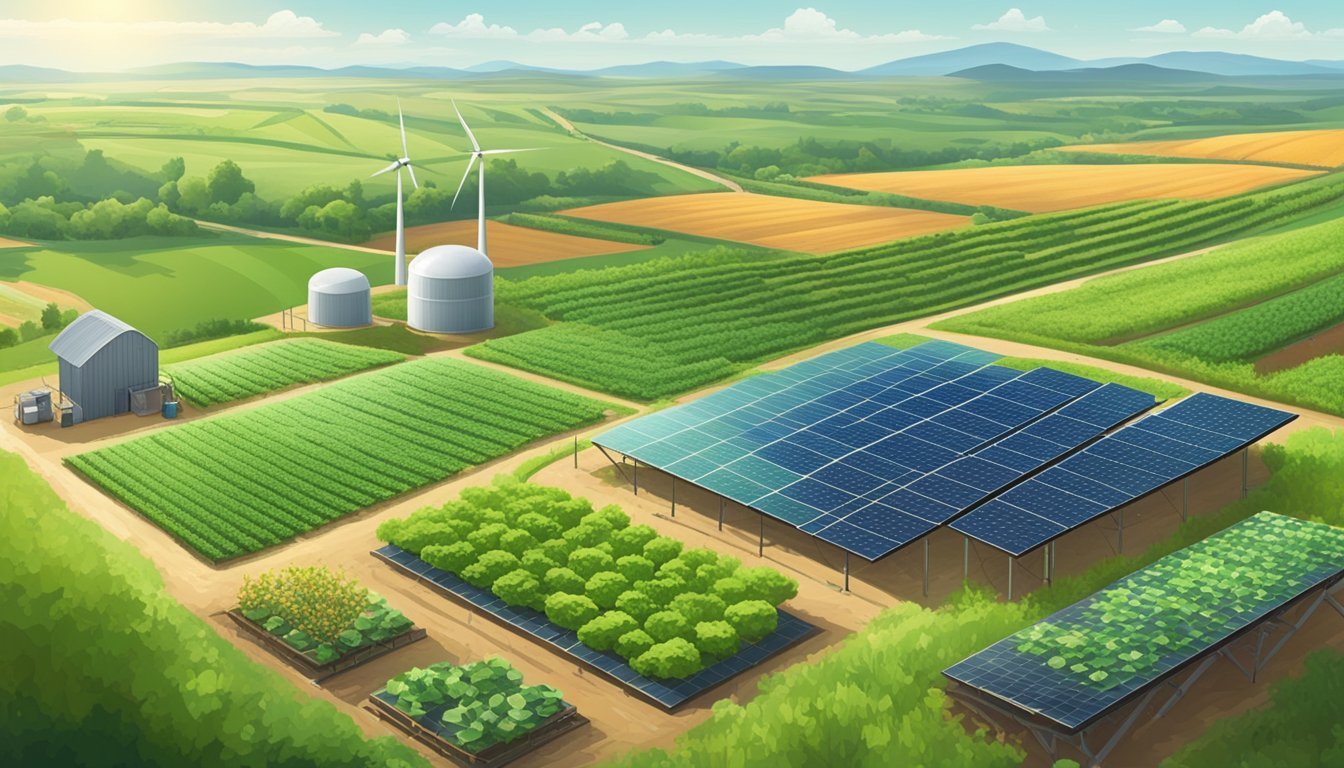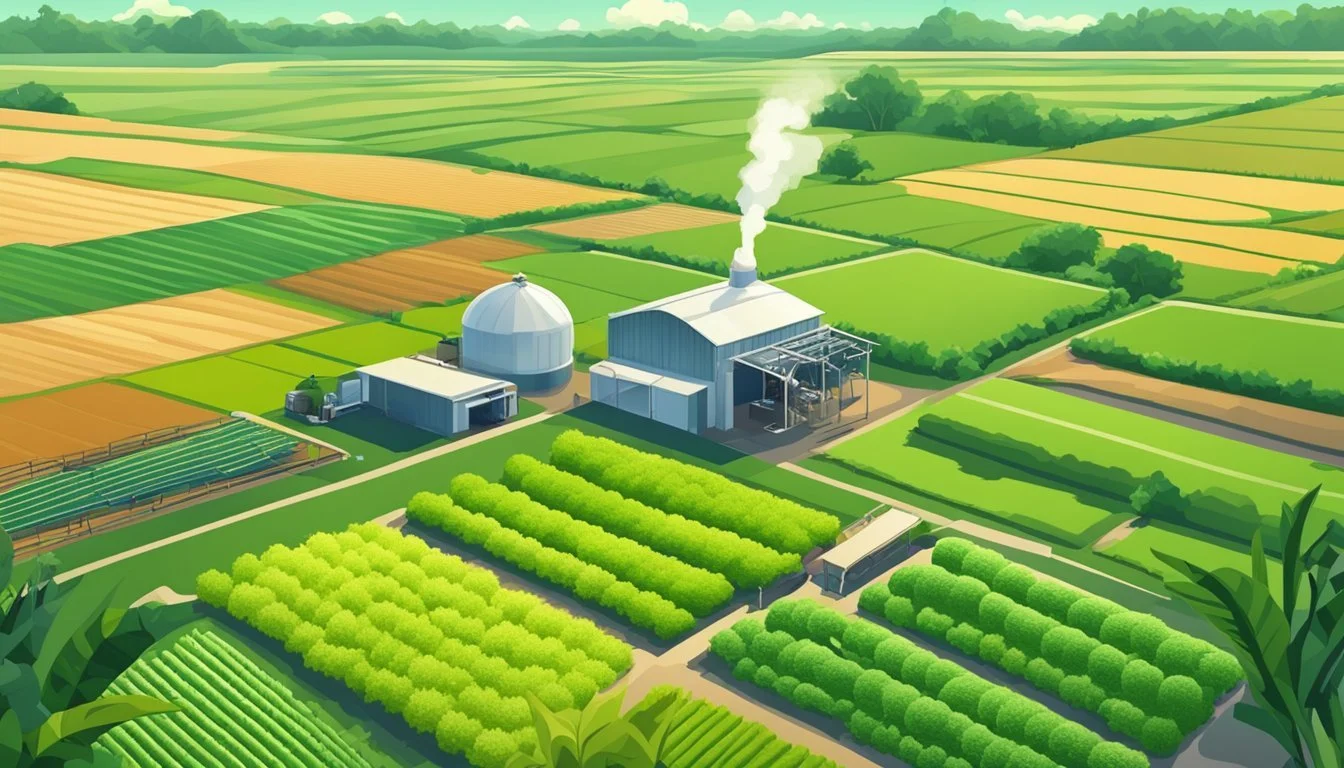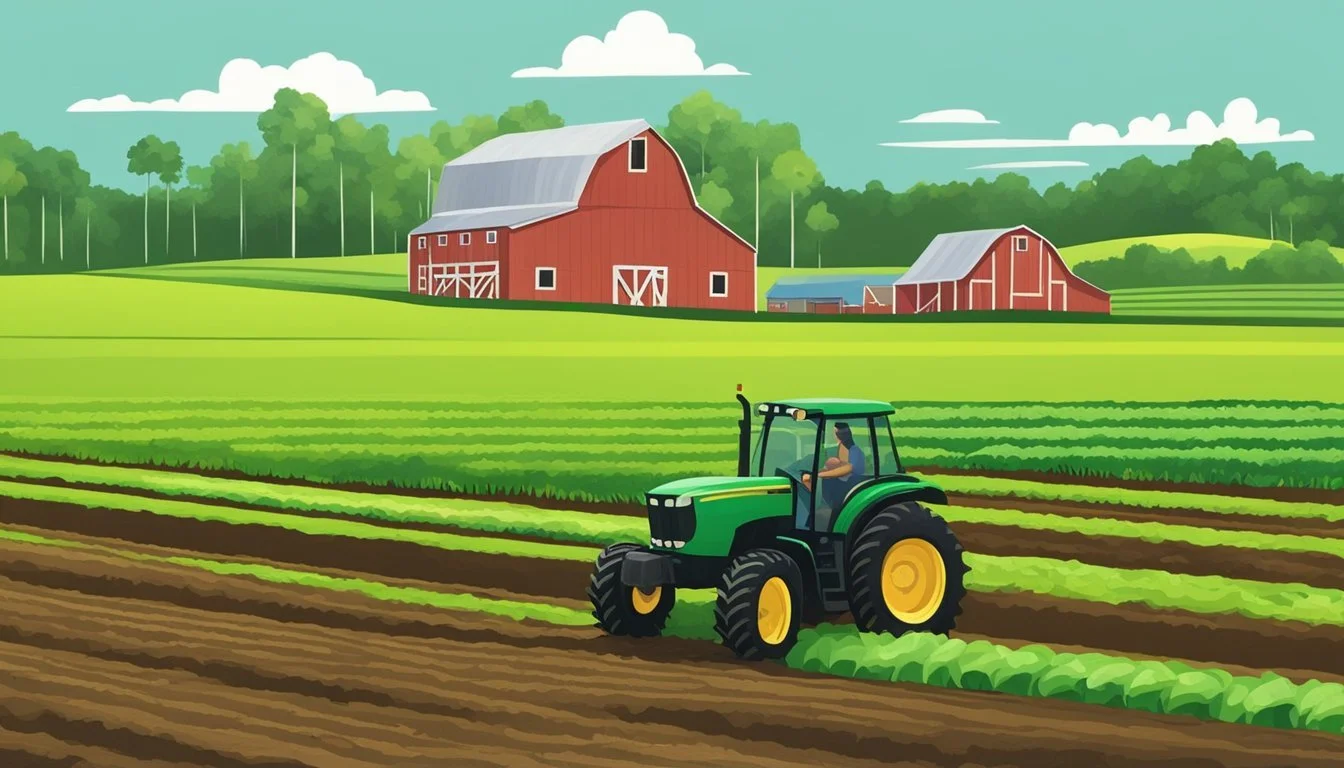Guide to Farming in Florida
Essential Tips for a Thriving Agribusiness
This Article is Part of Our State by State Farming Guide
Farming in Florida presents a unique set of opportunities thanks to the state's warm climate and extended growing seasons. With more than 300 different commodities produced, ranging from citrus fruits to vegetables, and a thriving livestock sector, the agricultural industry significantly contributes to Florida’s economy. For those entering the sector, understanding the regional climate differences—North, Central, and South Florida—is essential due to the state's varied weather patterns and soil types.
Florida's agricultural success stems from meticulous planning and adherence to recommended practices tailored to the state's diverse environments. Beginning farmers and seasoned professionals alike rely on resources like the University of Florida's research and extension services to guide them. They provide detailed monthly gardening calendars and planting guides to ensure optimal growth periods are utilized, emphasizing the importance of early and adequate preparation for planting seasons.
Support networks and a community of farmers offer additional advantages to beginning and experienced farm operators in Florida. With a considerable portion of Florida farmers relatively new to the industry, the state fosters a climate of innovation and adaptability. Best practices for crop selection, soil management, and sustainable farming techniques are shared among the community, bolstered by scientific insights and modern technologies that aim to maximize productivity while minimizing environmental impacts.
Understanding Florida's Climate
Florida's climate significantly influences agricultural practices, with its unique seasonal weather patterns and notable regional climate variations. Successful farming in Florida requires a deep comprehension of how climate factors such as temperature, sunlight, and precipitation change throughout the year and across the different regions of the state.
Seasonal Weather Patterns
Spring in Florida brings mild temperatures and increased rainfall, setting the stage for an abundant growing season. This is a vital period for planting and early growth, especially in Florida vegetable gardening, where timely planting can capitalize on the moderate temperatures and optimal sun exposure.
Summer is characterized by hot temperatures and a high degree of humidity, with frequent afternoon thunderstorms. Farmers must ensure that crops can withstand intense rainfall and potential flooding during this season, while also providing adequate water during drier spells.
Fall sees a gradual decrease in temperatures and humidity, creating an opportune time for harvesting many crops. The reduction in rain allows for easier harvesting conditions, while the mild weather supports the planting of winter crops.
Winter in Florida is relatively mild, with rare frosts or freezes. The subtropical parts of the state provide an ideal environment for year-round growing, but protection from unexpected cold snaps is essential to safeguard crops.
Regional Climate Variations: North, Central, and South Florida
North Florida experiences a more temperate climate with distinct seasonal changes and cooler winter temperatures compared to the rest of the state. It necessitates careful crop selection and timing to navigate the cooler and potentially freezing conditions.
Average winter temperatures: 40-60 degrees Fahrenheit
Average summer temperatures: 80-92 degrees Fahrenheit
Central Florida serves as a transitional zone with a blend of temperate and subtropical climates. The risk of frost is reduced yet still possible, and the region receives a balanced mix of rainfall and sunshine throughout the year.
Average winter temperatures: 50-70 degrees Fahrenheit
Average summer temperatures: 82-92 degrees Fahrenheit
South Florida boasts a true subtropical climate where winters are warm, and summers are hot and wet. This region supports a year-round growing season, with winter becoming a prime time for vegetable gardening due to the warm climate.
Average winter temperatures: 60-76 degrees Fahrenheit
Average summer temperatures: 85-95 degrees Fahrenheit
Farming in Florida requires adapting to these various climate conditions, with attention to the seasonal and regional differences that influence crop viability and productivity.
Soil Preparation and Management
Proper soil preparation and management are crucial for successful farming in Florida. These practices ensure the soil hosts the necessary conditions for vegetable growth, accommodating Florida's sandy soils and climate.
Soil Testing and Amendment
Before any planting, a soil test is essential to determine nutrient levels and soil pH. Florida's soil ranges from sandy to loamy, and its acidity could vary, thereby affecting nutrient availability. Lime can be applied to acidic soils to raise the pH, while sulfur may be used to lower an overly alkaline pH. Precise amendments are based on soil test results, aimed at achieving a pH level conducive to vegetable growth, generally around 6.5 to 6.8 for most crops.
Organic Matter and Composting
Incorporating organic matter into the soil can dramatically improve its structure, especially in Florida where sandy soils predominate. Compost is a valuable source of organic matter that benefits soil by improving water retention, fertility, and microbial activity. It is recommended to mix generous amounts of compost into the soil weeks ahead of planting, allowing time for integration and stabilization.
Types of Organic Matter:
Compost: Decomposed plant or animal materials
Manure: Aged livestock waste
Green Manure: Cover crops tilled back into the soil
Leaf Mold: Decomposed leaves
Mulching Techniques
Mulch is an essential component for moisture retention and temperature control. It helps conserve water, suppresses weed growth, and protects against soil erosion. In Florida's warm climate, mulching can also shield plant roots from high temperatures, which can be especially beneficial during the peak summer months.
Options for Mulch:
Straw
Grass Clippings
Pine Needles
Bark Chips
Soil solarization can also be a part of the preparation process, especially in controlling soilborne pathogens. This method involves covering the soil with clear plastic for several weeks during the hottest part of the year to increase soil temperatures to levels that kill harmful organisms. It's an eco-friendly method and can be advantageous before planting.
Water and Irrigation Practices
Water management is critical for sustainable farming in Florida, considering the state's unique climate and water table characteristics. Proper irrigation practices are key to conserving water resources while ensuring optimal crop growth.
Efficient Water Use
Efficient water use in Florida's agricultural sector involves the adoption of best management practices (BMPs) that match the specific needs of crops while considering local water availability. These practices are essential for protecting water quality and minimizing the consumption of this valuable resource. They include:
Regular Soil Moisture Monitoring: Utilizing tools like tensiometers or soil moisture sensors to determine the actual water needs of crops.
Water Conservation Methods: Implementing strategies such as rainwater harvesting and implementing precision irrigation to reduce runoff and evaporation.
Irrigation Systems and Scheduling
Irrigation Systems: Florida farmers have various irrigation systems at their disposal, each with its own set of advantages. Some commonly used systems include:
Drip Irrigation: Delivers water directly to the root zone, reducing water wastage.
Sprinkler Systems: Useful for a variety of crops, but slightly less efficient than drip systems due to evaporation losses.
Irrigation Scheduling: To maximize the effectiveness of any system, Florida farmers must develop irrigation scheduling that takes into account:
Crop Water Needs: Specific crops like watermelon have distinct water requirements at different growth stages.
Climate Data: Factoring in rainfall patterns and evapotranspiration rates to adjust irrigation accordingly.
By integrating these variables, farmers can tailor watering schedules precisely, ensuring that crops such as watermelon receive adequate hydration for prime growth without unnecessary water expenditure. This not only conserves water resources but also supports the health and yield of agricultural products.
Vegetable Gardening Essentials
In Florida's unique climate, vegetable gardening demands specific considerations for success. Here, one deals with planting dates, vegetable selection, and growing methods tailored to the region's conditions.
Choosing the Right Vegetables
Florida's climate allows for a wide range of vegetables, but not all varieties thrive equally. Gardeners should select vegetables adapted to Florida's hot and humid conditions. For example, sweet potatoes, southern peas, cherry tomatoes, and okra are known to perform well during the state's intense summers.
Cool Season: Lettuce, broccoli (how long does broccoli last?), and carrots are ideal for planting in the cooler months.
Warm Season: Choose heat-tolerant varieties like sweet potatoes and southern peas for warmer periods.
Planting Schedules and Techniques
Planting Dates: Gardening in Florida must respect the state's subtropical and tropical climate zones. Planting dates should be carefully planned, as certain vegetables can be grown year-round with attention to the timing.
Month Suitable Vegetables to Plant January-March Broccoli, lettuce, carrots April-May Heat-tolerant beans, corn June-August Sweet potatoes, okra September Cucumbers (how long do cucumbers last?), squash October-December Beets, cabbage, kale
Seeds vs. Transplants: Starting with seeds is cost-effective but may require more time and care. Transplants can give a quicker start, but they must be acclimated to the outdoor environment.
Raised Bed and Container Gardening
Raised bed gardens offer better drainage and can help control soil quality, which is beneficial in Florida's often sandy terrain. Container gardening is an excellent alternative for those with limited space or problematic soil.
Raised Beds: Create frameworks at least 3x3 feet, layering plant waste, kitchen scraps, or even animal manure for nutritious soil.
Containers: Ensure adequate size and drainage; use high-quality potting mix.
By focusing on the right vegetables, planting schedules, and growing environments, gardeners in Florida can create bountiful and healthy vegetable gardens.
Pest and Disease Management
In Florida farming, managing pests and diseases is crucial for maintaining healthy crops and maximizing yields. Effective management strategies are tailored to local conditions and integrate various control techniques.
Common Pests and Diseases
Pests:
Florida farmers regularly confront a range of insect pests, including:
Aphids: Sap-sucking insects that can spread diseases.
Nematodes: Microscopic roundworms that attack plant roots, reducing plant vigor.
Diseases:
The state's humid climate makes crops susceptible to common diseases such as:
Fungal Pathogens: Cause root rots, wilts, and leaf spots.
Bacterial Diseases: Lead to blights and cankers.
Integrated Pest Management Strategies
Cultural Practices: Farmers can reduce pest populations through:
Crop rotation to disrupt pest life cycles.
Selection of disease-resistant plant varieties.
Chemical Controls: When necessary, targeted application of pesticides helps manage pest outbreaks. However, it is vital to follow guidelines to prevent resistance.
Biological Controls: The introduction of natural predators or parasites can keep pest levels in check.
Monitoring and Identification: Regular scouting of fields enables early detection of problems, ensuring timely and precise interventions.
Crop Specific Guidelines
In Florida's diverse climate, crop-specific guidelines are essential for farmers to optimize growth and yield. Each vegetable group has distinct requirements for planting, soil composition, irrigation, and pest management.
Leafy Greens
Leafy greens like lettuce and spinach thrive in Florida's mild winters. They need well-drained soil rich in organic matter. Key planting months are from September to March. Farmers must regularly check for pests like aphids and manage them promptly.
Broccoli: Plants are sensitive to temperature; ideal temperatures range between 60-70°F. Broccoli should be planted in full sun and fertile, slightly acidic soil.
Spinach: Requires consistent moisture and a soil pH of 6.5 to 7.0. To avoid leaf spot diseases, watering at the base of the plants is recommended.
Root Vegetables
Root vegetables, including carrots, potatoes, and onions, require deep, loose soil to allow proper root expansion. Good drainage is paramount to prevent rot and other diseases.
Carrots: Grow best in sandy soils with a pH of 6.0 to 6.8. Seeds should be sown directly and thinned out early to avoid overcrowding.
Potatoes: Should be planted in early January in northern Florida and in February or March in southern parts. Hilling the soil around plants encourages tuber formation and prevents sunburn.
Onions: Need a pH between 6.0 and 6.8. Set onion bulbs in the soil with tops just showing, in rows 12 to 18 inches apart.
Fruiting Vegetables
Fruiting vegetables such as tomato, peppers, eggplant, and squash are popular among Florida farmers. They require full sun and consistent watering.
Tomatoes: Planting should occur during warm months, after the threat of frost has passed. Staking or caging is recommended to support the plant and improve air circulation.
Peppers: Need a long, warm growing season. Planting after the last frost and using mulch can conserve moisture and regulate soil temperature.
Eggplant: Prefers hot weather and fertile, well-drained soil. It should be planted in areas with full sun exposure and space plants 18 to 24 inches apart in rows.
Squash: Plant in a sunny spot with fertile, well-drained soil, and give plenty of space between plants to allow for air circulation and reduce mildew risks.
Harvesting and Post-Harvest Handling
In Florida's diverse agricultural landscape, mastery of harvesting and post-harvest handling is critical to maintaining the quality and longevity of produce, particularly for fresh vegetables and specialty crops.
Proper Harvesting Techniques
Harvesting should be timed precisely to ensure that vegetables are picked at optimal maturity. This not only guarantees peak flavor and nutrition but also maximizes shelf-life post-harvest. Farmers utilize various indicators such as color, size, and firmness to judge the right time for harvest. Florida's stonefruits, like peaches, for example, should demonstrate a characteristic color and give slightly under gentle pressure when they're ready to be picked.
Key considerations for harvest include:
Monitoring Maturity Signs: Look for changes in color, size, and texture.
Handling with Care: Minimize bruising by using gentle techniques.
Tool Maintenance: Regularly sharpen and disinfect cutting tools to prevent disease.
Storage and Preservation
Post-harvest, proper storage and preservation are vital to minimize losses and maintain the quality of the harvest.
Storage conditions for Florida produce:
Produce Type Temperature (°F) Relative Humidity (%) Leafy greens 32-36 90-95 Stonefruits 31-32 90-95 Citrus fruits 38-48 85-90
For long-term storage, farmers should ensure facilities are clean and temperature-controlled. Reducing the produce's exposure to ethylene gas, which can hasten ripening and spoilage, is also a key measure for extending post-harvest life. Fresh vegetables like leafy greens must be refrigerated promptly to preserve freshness and prevent wilting.
Best practices for preservation:
Refrigeration: Store sensitive crops at optimal temperatures.
Humidity Control: Maintain appropriate humidity levels for each produce type.
Sanitation: Regularly clean storage areas to prevent contamination.
Sustainable Farming Practices
Sustainable farming practices in Florida are crucial for ensuring long-term agricultural productivity and environmental health. The implementation of such practices assists farmers in producing crops and livestock in a more eco-friendly manner while preserving natural resources.
Organic Farming Principles
Organic farming in Florida emphasizes the use of natural substances and farming methods. Key to this approach is the enhancement of soil fertility through the incorporation of organic matter such as compost and green manure. Chemical fertilizers and synthetic pesticides are avoided to protect soil health. The principles of organic farming also mandate careful stewardship of water resources and, often, the inclusion of livestock, which adds manure—further enriching the soil.
Crop Rotation and Diversity
Crop rotation is a fundamental strategy to maintain the fertility of the soil and manage pests and diseases. The practice involves alternating the types of crops grown on a particular piece of land with each growing season. By doing this, a variety of nutrients are used and replenished in the soil.
Example of Crop Rotation Schedule:
Year 1: Legumes (fixes nitrogen in the soil)
Year 2: Leafy greens (heavy nitrogen consumers)
Year 3: Root vegetables (break up soil, less nitrogen needed)
Furthermore, diversity in crop production is not only beneficial for the soil but also for the protection against market fluctuations, which is vitally important for agribusiness sustainability. A diverse array of crops can attract beneficial insects and can reduce the likelihood of complete crop failure due to pests or disease.
Planning and Economics
In Florida's agriculture, meticulous planning and economic considerations are pivotal for both fledgling and seasoned farmers. Strategic layout and judicious financial management underscore successful farm operations.
Farm Planning and Layout
Farming in Florida necessitates a strategic approach to the utilization of space and resources. Farmers need to meticulously design their farm layout to optimize crop production and ensure efficient use of land. They must consider the specific requirements of the crops they choose to grow, including soil type, climate, and water availability. Appropriate planning also involves the positioning of fields, irrigation systems, and other infrastructure to support their agricultural activities.
Effective farm planning includes:
Selection of crops: Suited to Florida's climate and market demand.
Soil assessment: To determine the best crop cultivation strategies.
Water management: Essential in Florida's varied climate for irrigation and drainage needs.
Infrastructure placement: Strategic location of barns, roads, and storage for operational efficiency.
Economic Considerations and Marketing
Economic success for ranchers and farmers in Florida hinges on financial planning and marketing acumen. Understanding the commodities market, production costs, and the competitive landscape is crucial.
Key financial considerations involve:
Budgeting: Farmers must create comprehensive enterprise budgets that factor in all costs from seed to market.
Financing: Access to capital through loans or grants can be vital for starting and expanding farm operations.
Cost analysis: Regular review of financial performance helps in making informed decisions about existing operations and potential expansions.
Marketing strategies are equally important as they determine the profitability of farm produce.
Market research: Knowing consumer trends and preferences guides crop selection and marketing tactics.
Sales channels: Diverse avenues, from farmers' markets to wholesale contracts, ensure broader market reach.
Value-added products: This can increase profitability and marketability of farm produce.
A well-planned farm layout coupled with robust economic analysis and marketing strategies fortifies a farm's success in Florida's agricultural sector.
Support and Resources for Florida Farmers
Farmers in Florida have access to a variety of support systems and resources. These are tailored to assist with both the practical aspects of farming and navigating the regulatory environment. Key initiatives include the Florida Cooperative Extension Service and various forms of agricultural assistance.
Florida Cooperative Extension Service
The Florida Cooperative Extension Service operates through the University of Florida's Institute of Food and Agricultural Sciences (IFAS). It offers science-based expertise on agriculture, horticulture, and various other areas. Extension agents deliver educational resources and personalized assistance to help farmers maximize their productivity and sustainability.
Services Provided:
Educational workshops and seminars
Personal consultations
Resource materials, such as the Florida Gardening Calendar
Agricultural Regulations and Assistance
When it comes to agricultural regulations in Florida, farmers can seek guidance and support from the office of Commissioner Wilton Simpson. As the head of the Florida Department of Agriculture and Consumer Services, Commissioner Simpson's office is pivotal in helping establish policies that benefit the farming community and in offering assistance for regulatory compliance.
Assistance programs and services include:
Guidance on best practices for conservation and sustainability
Support for beginning farmers and ranchers
Information on funding opportunities for farm operations
Technical advice through entities like the Natural Resources Conservation Service (NRCS)
Month-by-Month Farming Calendar
In Florida, diligent planning is essential for a farmer's success due to the state's unique climate zones. This calendar is crucial for optimizing planting and harvest timings.
Calendar of Planting and Harvesting
January to February (Winter into Spring):
Plant strawberries and tomatoes in preparation for a spring harvest.
Cold-hardy crops such as kale, broccoli, and lettuce can be planted.
March to May (Spring):
Begin planting heat-tolerant vegetables like okra, sweet potatoes, and cucumbers.
Summer staples such as watermelon and cantaloupe (how long does cantaloupe last?) should be sown.
June to August (Summer):
Focus on maintaining crops, as high temperatures and humidity can encourage pests and diseases.
Late summer is ideal for starting seedlings for fall planting.
September to November (Fall):
Initiate fall gardens by planting root vegetables and leafy greens.
In September, farmers may start planting citrus trees and prepare for the cooler months ahead.
December (Winter):
Time to harvest fall-planted crops.
In South Florida, this is also a good time to plant tomatoes and peppers, which will yield produce in early spring.
Advanced Topics in Farming
In Florida's diverse agricultural sector, advanced farming topics are gaining traction as farmers seek to optimize productivity in a challenging climate. Embracing high-tech solutions and community-driven initiatives is essential for sustainability and progress.
High-Tech and Innovative Techniques
Florida's unique climate and weather conditions necessitate the adoption of innovative farming technologies. Farmers are increasingly harnessing high-tech and precision agriculture solutions to address water scarcity and maximize the abundant sunshine, essential for crops like Bloomsdale Long Standing and Malabar Spinach. Advanced irrigation systems that conserve water and tools for climate-smart agriculture help farmers to adapt and mitigate the effects of unpredictable weather patterns.
Drones and sensors gather crucial data, guiding decisions from planting to harvest. They play a pivotal role in monitoring crop health and soil moisture levels, ensuring that plants like Salad Bowl Lettuce, Red Sails Lettuce, and Oak Leaf Lettuce receive the optimal amount of water and nutrients.
Agri-Tourism and Community Involvement
Agri-tourism bridges the gap between agriculture and community involvement, offering an interactive platform for education and revenue diversification. Farmers in Florida capitalize on the region's sunshine and warm weather, inviting locals and tourists to pick-your-own farms and seasonal events during peak bloom periods.
Community-supported agriculture (CSA) programs are popular, where stakeholders can support local agriculture and receive a share of the harvest. This engagement promotes a better understanding of the complexities inherent to farming in Florida's climate, fosters community involvement, and bolsters the local economy.
Profiles of Popular Florida Crops
Florida is renowned for its diverse range of crops which contribute significantly to both the state's economy and the health of consumers. This section will explore the economic importance and production statistics of these crops as well as their nutritional benefits.
Economic Impact and Production Stats
Florida agriculture thrives with a variety of crops, but some of the standout contributors in terms of economic impact and production include tomatoes, watermelons, sweet corn, and cucumbers. These crops not only serve the local markets but are also pivotal to the export economy.
Tomatoes: Once holding the top spot among Florida's vegetable crops, tomato production has faced a decline, with values plummeting by -35%.
Watermelons: In contrast, watermelon production has seen a rise by +17%, indicating a growing market for this hydrating fruit.
Sweet Corn: It has experienced growth with a notable +35% increase in value.
Cucumbers: Solidifying their space in the market, cucumbers have enjoyed a +23% uptick in value.
While not in the top list for economic impact, other important crops include lettuce, carrots, beans, and broccoli, contributing to Florida’s agricultural diversity.
Nutritional and Health Benefits
These popular Florida crops offer a range of health benefits, containing essential vitamins, minerals, and fibers.
Tomatoes: They are rich in vitamins C and K, potassium, and lycopene, an antioxidant linked to reduced risk of heart disease and cancer.
Carrots: Loaded with beta-carotene, which is converted into vitamin A in the body, carrots are vital for good vision and immune function.
Beans: A great source of protein, beans also provide dietary fiber, iron, and B vitamins.
Cucumber: High in water and low in calories, cucumbers are hydrating and contain several important vitamins and minerals.
Lettuce: Offers hydration, fiber, and vitamins A and K.
Broccoli: Packed with vitamins C and K, fiber, and compounds known for their cancer-preventing properties.
Watermelon: Besides being refreshing, watermelon is a good source of vitamins A and C, potassium, and antioxidants.
Sweet Corn: Offers energy, vitamins B and C, magnesium, and fiber.
Consuming these crops contributes to a balanced diet and supports overall health, showcasing Florida’s role in providing nutritious produce to the population.
Conclusion
The agricultural landscape of Florida is poised for innovative changes, propelled by technological advancements and legislative developments. The importance of farming in Florida's economy is underscored by the state's commitment to the sector through legal frameworks like the Florida Right to Farm Act and modern initiatives supportive of small and alternative enterprises.
Farmers in Florida navigate a complex environment that includes embracing new technologies and grappling with legislative changes. The recent Farm Bill, for instance, has introduced both opportunities and challenges, demanding a thorough understanding of its implications for legal and operational strategies.
The state's farming future looks to balance tradition with progress, where digital tools and machinery pave the way for increased productivity and sustainability. Florida's agricultural community, including those who are relatively new to farming, is encouraged to engage in proactive planning, both in the short and long term, to ensure continued success and growth.
Key Takeaways for Florida Farmers:
Adapt: Embrace technological innovations to enhance farming practices.
Understand: Stay informed about legislative changes, especially those related to the Farm Bill and the Right to Farm Act.
Plan: Focus on both immediate and future planning for sustainable farm operations.
Support: Engage with the farming community and resources, such as the University of Florida's extension programs aimed at small farms and alternative enterprises.
The guiding principles for farming in Florida center on intelligent adaptation, legal cognizance, strategic planning, and community support—essential for the state to remain at the forefront of agricultural productivity and innovation.













